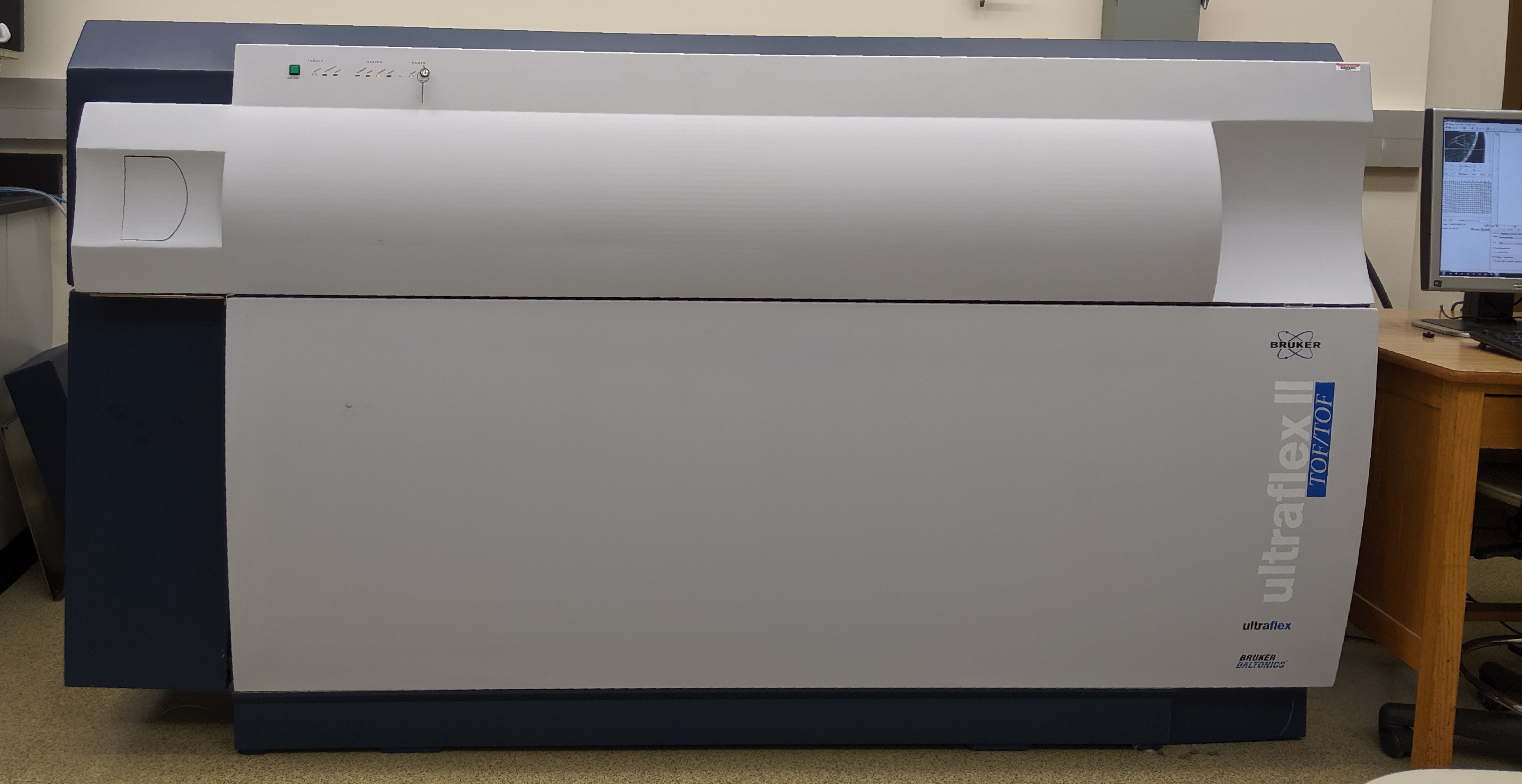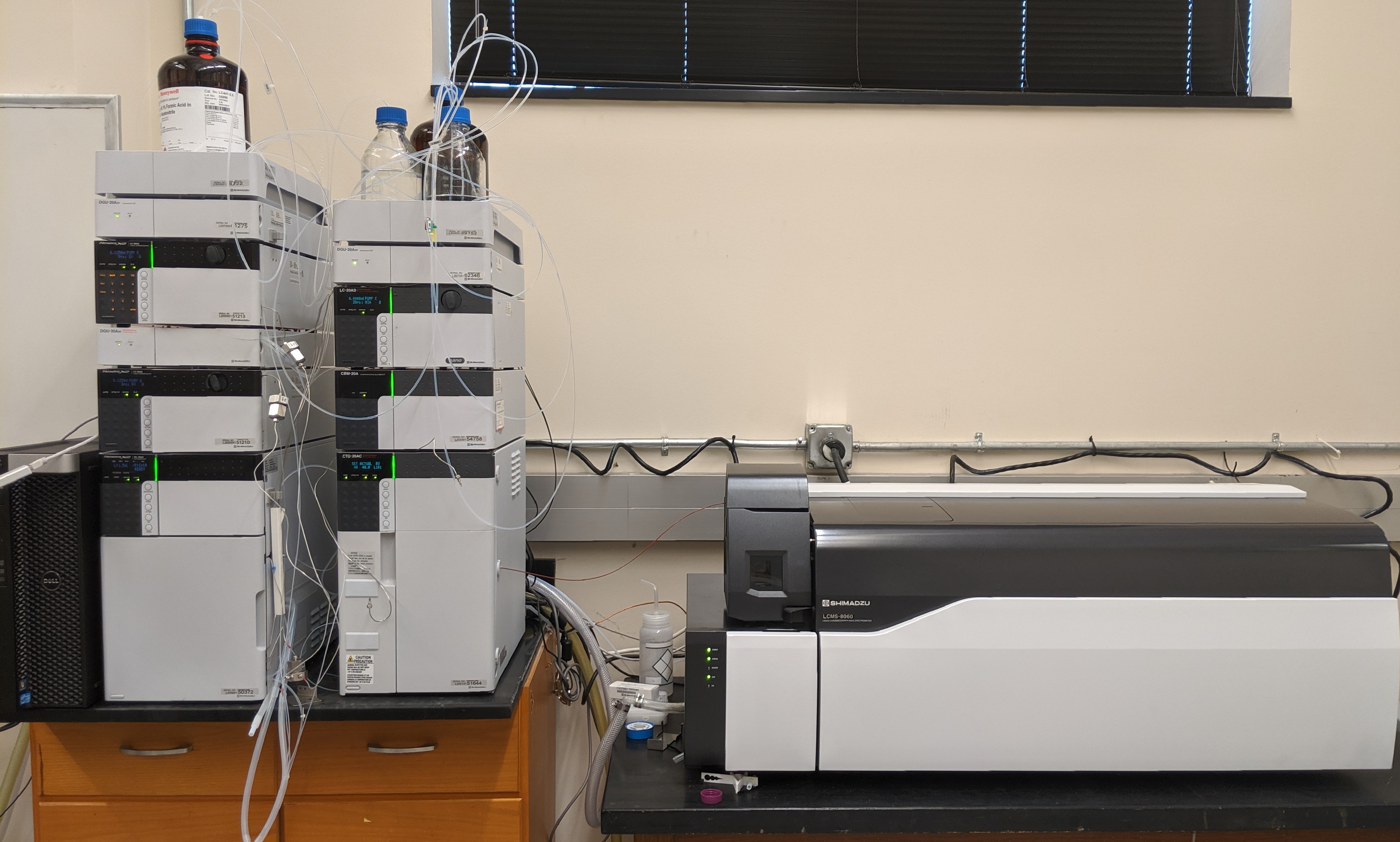Instrumentation
Organic and Biological Mass Spectrometry
High Performance Laboratory (Chemistry)
|
Bruker Ultraflex II MALDI-TOF
|
This instrument is designed for the analysis of very polar or high molecular weight
compounds. Vaporization and ionization are facilitated by co-dissolving the sample
and a light adsorbing matrix which is also typically either acidic or basic. A microliter
of the sample/matrix solution is evaporated on a target that is placed in the path
of a laser beam. Since ionization is accomplished by proton transfer, the sample must
have a heteroatom that can either accept or donate a proton to effect a charge. Typically
the heteroatom is either a nitrogen or an oxygen. (Nitrogen gives better results,
it is typically more basic.) An exception is that salts or molecules which already
have a net charge do not require a proton transfer, and need only be desorbed from
the matrix. This instrument is also configured for tandem MS operations aimed at
the detection of spontaneous fragments from mass selected precursor ions. In addition
to providing clues regarding molecular structure this technique is well suited for
peptide sequencing. Because of the abundant matrix compound, this method is usually
applied to molecules with a mass of over 500 Daltons. The upper mass limit of this
instrument is about 80 Kda.
|
|
Bruker Amazon Ion Trap Capillary LC/MS/MS |
This electrospray LC/MS instrument is interfaced with a capillary reverse phase HPLC system and used almost exclusively for the analysis of protein digests. With dedicated proteomics software it is capable of identifying peptides in complex mixtures produced by digestion of proteins, whose resulting peptide fragments are HPLC separated and sequenced using tandem mass spectrometry. The protein identifications can also incorporate peptide mass fingerprinting data, obtained on this instrument or externally. While not as capable as the myriad of dedicated high throughput proteomics instruments located in our sister-facility at the University of Arkansas for Medical Sciences, these instruments are useful for screening applications and preliminary experiments that can be conducted using this much less expensive technology. They are also well suited for targeted applications.
|
|
Shimadzu 8040 UPLC/MS/MS
|
This triple quadrupole LC/MS system is interfaced to a UPLC rather than a standard
reverse-phase HPLC, producing high-level on-line chromatography with peak widths on the order of 6 seconds. This capability dramatically increases the number of components that can be separated online from a complex mixture. This instrument utilizes an electrospray ionization
(ESI) source and is suitable for polarcompounds that can be ionized by proton transfer or that are already ionic in nature. This instrument is primarily designed for quantification of targeted compounds, based on UPLC separation and tandem mass spectrometry (multiple reaction monitoring,
or MRM) and can produce sub-ppb limits of detection and quantitation. Current projectsinclude environmental and water quality analysis, endocrine disruptors, and heterocyclic amines.
It should be pointed out that sample preparation is critical to successful ultra-trace analysis and samples should be properly processed and cleaned up prior to mass spectral analysis.
|
|
Shimadzu 8060 UPLC/MS/MS
|
This triple quadrupole GC/MS is interfaced to an AOC6000 autosampler, capable of classical liquid injection, headspace vapor injection, or SPME injection. GC/MS is intended
for samples that are volatile or semi-volatile. Generally this corresponds to samples that are soluble in hexane or similarorganic solvents rather than water. Ionization is effected by electron impact, giving library searchable fragmentation profiles which are used in conjunction with
the NIST mass spectra database for tentative compound identification.
|
|
Shimadzu LCMS-IT-TOF |
This instrument combines ion trap and time-of-flight mass analyses and is capable of providing high resolution/mass accuracy in both MS and MSn modes. It is coupled to a UPLC similar
to the 8040 and 8060 systems described above and also utilizes an ESI source.
|
|
Shimadzu 8040 GC/MS/MS |
This triple quadrupole GC/MS is interfaced to an AOC6000 autosampler, capable of classical liquid injection, headspace vapor injection, or SPME injection. GC/MS is intended
for samples that are volatile or semi-volatile. Generally this corresponds to samples that are soluble in hexane or similarorganic solvents rather than water. Ionization is effected by electron impact, giving library searchable fragmentation profiles which are used in conjunction with
the NIST mass spectra database for tentative compound identification.
|
Agricultural Applications and Supervised Self Service Laboratory (Poultry Science)
|
Bruker Reflex III MALDI-TOF
|
This instrument is designed for the analysis of very polar or high molecular weight compounds. Vaporization and ionization are facilitated by co-dissolving the sample and a light adsorbing matrix which is also typically either acidic or basic. A microliter of the sample/matrix solution is evaporated on a target that is placed in the path of a laser beam. Since ionization is accomplished by proton transfer, the sample must have a heteroatom that can either accept or donate a proton to effect a charge. Typically the heteroatom is either a nitrogen or an oxygen. (Nitrogen give better results, it is typically more basic.) An exception is that salts or molecules which already have a net charge do not require a proton transfer, and need only be desorbed from the matrix. Because of the abundant matrix compound, this method is usually applied to molecules with a mass of over 500 Daltons. The upper mass limit of this instrument is about 80 Kda. This instrument is operated by the facility staff and is also sometimes available for supervised self-service for facility trained users.
|
|
Bruker Esquire-LC Ion Trap LC/MS |
This is a quadrupole ion trap mass spectrometer, equipped with an electrospray ionization source and interfaced with a Hewlett Packard 1100 reverse phase HPLC. Samples can be introduced directly from the liquid chromatograph or in solution through a sample infusion interface. The instrument has a mass range of 20 to 2000 m/z when scanning at 13,000 amu per second with unit mass resolution. This instrument is operated by the facility staff and is also sometimes available for supervised self-service for facility trained users.
|
|
Agilent 6890 GC/MS
|
This is a single quadrupole GC/MS coupled toan autosampler capable of liquid injections. GC/MS is intended for samples that are volatile or semi-volatile. Generally this corresponds to samples that are soluble in hexane or other organic solvents rather than water. Ionization is effectedby electron impact, giving library searchable fragmentation profiles which are used in conjunction with the NIST mass spectra database for tentative compound identification. This instrument isprimarily used for FAMEs analysisand is available for supervised self-service for facility trained users. |
The Stable Isotope Ratio Mass Spectrometry Laboratory (This link leads to the webpage for this part of our facility.)




